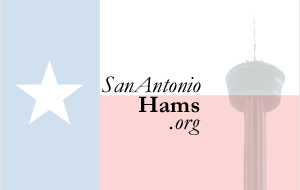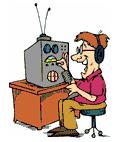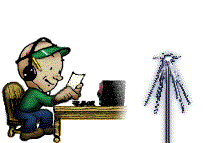| VHF
/ UHF Local Radio Nets - Voice |
| Date
/ Time |
Frequency
/ PL Tone |
Sponsor
/ Callsign |
Notes
/ Comments |
| Daily
@ 6:30pm |
147.14
+ Repeater (179.9 tone)
(Canyon Lake) |
Central
Texas Traffic Net |
 NTS
Traffic Net. Net meets each night for the purpose of
collecting and passing traffic as part of the National Traffic
System (NTS) . This is a directed net open to all interested Amateurs
with or without traffic to be passed. NTS
Traffic Net. Net meets each night for the purpose of
collecting and passing traffic as part of the National Traffic
System (NTS) . This is a directed net open to all interested Amateurs
with or without traffic to be passed.
Traffic
Handling:
A.
Traffic handling is relaying messages from the place of origination
to its destination where it is received by or delivered to the
addressee.
B.
NTS refers to the National Traffic System - an efficiently organized
system for moving messages to their destinations. It includes:
- A standard
message format for ease and accuracy in relaying.
- Scheduled
nets meet on designated frequencies at specified times to relay
messages.
C.
Net protocol or procedures vary between nets but all include:
- A net
control station (NCS)- person who directs all net activity
- A preamble
that includes the name and purpose of the net, the net control’s
call and sometimes the name and location.
- A designated
time for representatives to/from other nets to check in.
- A designated
time for bulletins or announcements of general interest.
- A designated
time for stations to check in (order may vary - listen to NCS).
|
| Sunday @ 8:30pm |
146.94 - Repeater (179.9 tone) |
Quarter Century Wireless |
 Club Net. Net meets weekly for those Amateurs interested in the activities of QCWA local chapter. This is a directed net open to all interested Amateurs. Club Net. Net meets weekly for those Amateurs interested in the activities of QCWA local chapter. This is a directed net open to all interested Amateurs. |
| Monday
@ 7:30pm |
146.76
-
No tone |
Chaparral
(Seguin) |
 Info
Net. This is a directed net open to all interested Amateurs.It
is believed to also do double duty as a local ARES net. Most participants
from Guadalupe County / Seguin area. Info
Net. This is a directed net open to all interested Amateurs.It
is believed to also do double duty as a local ARES net. Most participants
from Guadalupe County / Seguin area. |
| Monday
@ 8:30pm |
147.38
+ and
443.875 + linked Repeater
(162.2 tone) |
Alamo
Area Radio Organization AA5RO
|
 Info
Net. Club plays back recording of the Amateur Radio Newsline,
followed by general check-ins by club officers and members, plus
any visitors.This is a directed net open to all interested Amateurs.
This net generally lasts about 50-60 minutes, including the 20-30
minute AR Newsline recording. Info
Net. Club plays back recording of the Amateur Radio Newsline,
followed by general check-ins by club officers and members, plus
any visitors.This is a directed net open to all interested Amateurs.
This net generally lasts about 50-60 minutes, including the 20-30
minute AR Newsline recording.
CW Code Practice may occur following this net. |
| Tuesday
@ 7:00pm |
146.64
-
(88.5 tone) |
Kendall
Amateur Radio Society (KARS) |
 Info
Net. This is a directed net open to all interested Amateurs.
They traditional pass control from operator to operator down the
list in the order of initial check-in to allow comments to be made
in the manner, and to get operators used to be net control. Info
Net. This is a directed net open to all interested Amateurs.
They traditional pass control from operator to operator down the
list in the order of initial check-in to allow comments to be made
in the manner, and to get operators used to be net control. |
| Tuesday
@ 8:00pm |
443.400
+
(100 tone) |
SAHARA
KD5GAT
|
 Info
/ EchoLink Net. Net is open to all licensed Amateurs and
is bilingual. EchoLink node is KD5GAT-L, linked to other Texas and
Mexico amateur repeaters. Info
/ EchoLink Net. Net is open to all licensed Amateurs and
is bilingual. EchoLink node is KD5GAT-L, linked to other Texas and
Mexico amateur repeaters. |
| Tuesday
@ 8:30pm |
147.18
+ Repeater (103.5 tone) |
San
Antonio Emergency Management Communications K5EOC |
 Emergency
Communications Training Net. Net meets weekly as a training
net for those Amateurs involved with the San Antonio Emergency Managment
Communications organization. This is a directed net open to all
interested Amateurs. Emergency
Communications Training Net. Net meets weekly as a training
net for those Amateurs involved with the San Antonio Emergency Managment
Communications organization. This is a directed net open to all
interested Amateurs. |
| Wednesday
@ 8:30pm |
146.94
- Repeater
(179.9 tone) |
San
Antonio Repeater Organization WA5UNH
www.sarepeater.net |
 Info
Net. Club reads current ARRL Electronic Newsletter following
general check-ins by club officers and members, plus any visitors.This
is a directed net open to all interested Amateurs. This net generally
lasts about 30-40 minutes. Special note of interest, the net control
usually asks for check-ins by club officers for other clubs, other
than SARO. This is the best time to reach an officer from this club. Info
Net. Club reads current ARRL Electronic Newsletter following
general check-ins by club officers and members, plus any visitors.This
is a directed net open to all interested Amateurs. This net generally
lasts about 30-40 minutes. Special note of interest, the net control
usually asks for check-ins by club officers for other clubs, other
than SARO. This is the best time to reach an officer from this club.
|
| Thursday
@ 8pm |
146.86
+ Repeater
(123 tone) |
Radio
Operators of South Texas W5ROS
www.w5ros.org |
 Info Net . This is a directed net open to all interested Amateurs. R.O.O.S.T. members rotate net control duties. This net generally lasts about 20-40 minutes, depending on how much participants have to report. Info Net . This is a directed net open to all interested Amateurs. R.O.O.S.T. members rotate net control duties. This net generally lasts about 20-40 minutes, depending on how much participants have to report.
|
| Saturday@
10:30pm |
147.38
+ Repeater
443.875 + Repeater
(162.2 tone) |
Alamo
Area Radio Organization AA5RO
users.stic.net/aaro |
 Night
Owl Net. This is a directed net open to all interested
Amateurs. Topics range widely and wildly in nature, but participants
are encouraged to list any items for sale or trade, or want lists
to the net. This net generally lasts about 90 minutes or less, depending
on the crowd. Night
Owl Net. This is a directed net open to all interested
Amateurs. Topics range widely and wildly in nature, but participants
are encouraged to list any items for sale or trade, or want lists
to the net. This net generally lasts about 90 minutes or less, depending
on the crowd.
CW Code Practice 30 minutes prior to this net. |
| Most
nights @ 10:30pm |
147.38
+ and
443.875 + linked Repeater
(162.2 tone) |
Alamo
Area Radio Organization AA5RO
users.stic.net/aaro |
 Cheap
Entertainment Net. This is a directed net open to all interested
Amateurs. Topics range widely and wildly in nature, but participants
are encouraged to list any items for sale or trade, or want lists
to the net. This net generally lasts about 90 minutes or less, depending
on the crowd. Content similar to the "Night Owl Net" held
on Saturdays by the same club. Cheap
Entertainment Net. This is a directed net open to all interested
Amateurs. Topics range widely and wildly in nature, but participants
are encouraged to list any items for sale or trade, or want lists
to the net. This net generally lasts about 90 minutes or less, depending
on the crowd. Content similar to the "Night Owl Net" held
on Saturdays by the same club. |
| As
Needed |
146.94
- Repeater (179.9 tone) |
San
Antonio Radio Club W5SC and
San Antonio
Repeater Organization WA5UNH |
 Skywarn
Net. This net is only called when activated by the National
Weather Service.This is a directed net open to all interested Amateurs.
Please listen and follow Net Control's directions as they may be
dealing with emergency situations and requesting specific types
of rainfall or weather data. If they ask for anyone with severe
weather in their area, and you have only light rain, please do not
check in to report such. Skywarn
Net. This net is only called when activated by the National
Weather Service.This is a directed net open to all interested Amateurs.
Please listen and follow Net Control's directions as they may be
dealing with emergency situations and requesting specific types
of rainfall or weather data. If they ask for anyone with severe
weather in their area, and you have only light rain, please do not
check in to report such. |
|
| 220
Mhz Local Radio Nets |
| Date
/ Time |
Frequency |
Sponsor
/ Callsign |
Notes
/ Comments |
| Tuesday
@ 8:30pm |
224.380 (-) with no PL |
Ken, K5KEG or Marty, KB5MJC |
220 Info Net
 There is no particular ham club affiliation or sponsor, just a bunch of radio operators who enjoy talking on 220 mhz. There is no particular ham club affiliation or sponsor, just a bunch of radio operators who enjoy talking on 220 mhz. |
|
| 6
Meter Local Radio Nets |
| Date
/ Time |
Frequency |
Sponsor
/ Callsign |
Notes
/ Comments |
| Monday
@ 8:00pm |
52.525
mHz FM - Voice |
Marty,
KB5MJC |
Southwest Texas 6 Meter Net.
 Net control recommends using vertical polarization, although some operators have been known to flip over to horizontal while on the net. (Does that mean they are laying down?) There is no particular ham club affiliation or sponsor, just a bunch of radio operators who enjoy talking on 6 meters.
Net control recommends using vertical polarization, although some operators have been known to flip over to horizontal while on the net. (Does that mean they are laying down?) There is no particular ham club affiliation or sponsor, just a bunch of radio operators who enjoy talking on 6 meters. |
| Thursday
@ 6:30pm |
50.130
mHz USB Voice |
Greg Lewis ,
N5XO |
 6 Meter Net, 6 Meter Net,
This is just a net used by the Unusual Suspects {voice}, we just have conversation there on Thursdays scheduled
and any other time similar to our activity on 2 meters. The goal is to use 6 meters and have activity there so in the
even the band opens, we can make some contacts. But it is just normal conversation round table, no strict net rules or such. Open to anyone on the planet earth,
|
|
| 10
Meter Local Radio Nets |
| Date
/ Time |
Frequency |
Sponsor
/ Callsign |
Notes
/ Comments |
| Thursday
@ 7:00pm |
28.120 MHz |
Bob,
K5AUW |
 PSK31 Net PSK31 Net
Practice using PSK31 on 10 meters, setting up local point to point communications. |
 San Antonio Area Hams
San Antonio Area Hams 
 With the advent of Hurricane Katrina and Rita visiting next door during 2005, these HF nets have become very active and very important to the disaster response efforts of this nation. Below is a list of known nets on 80, 40 and 20 meters. Some frequencies are used only in daytime and others at night. Some are used 24/7.
With the advent of Hurricane Katrina and Rita visiting next door during 2005, these HF nets have become very active and very important to the disaster response efforts of this nation. Below is a list of known nets on 80, 40 and 20 meters. Some frequencies are used only in daytime and others at night. Some are used 24/7. 